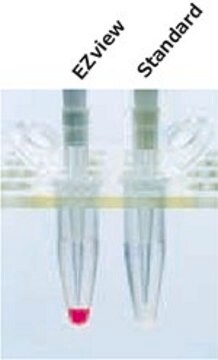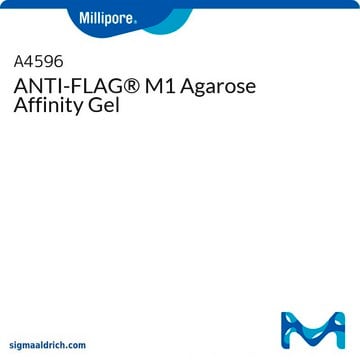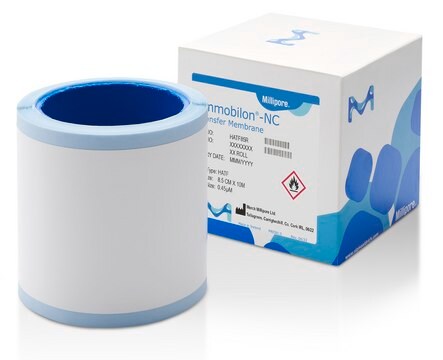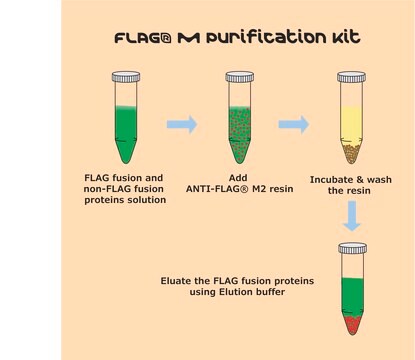Alle Fotos(1)
Wichtige Dokumente
11815024001
Roche
Anti-Protein C Affinity Matrix
from mouse IgG1κ
Synonym(e):
affinity matrix, anti-protein c
Anmeldenzur Ansicht organisationsspezifischer und vertraglich vereinbarter Preise
Alle Fotos(1)
About This Item
UNSPSC-Code:
12352203
Empfohlene Produkte
Biologische Quelle
mouse
Qualitätsniveau
Konjugat
agarose conjugate
Antikörperform
purified immunoglobulin
Klon
HPC4, monoclonal
Form
slurry
Verpackung
pkg of 1 mL (settled resin volume)
Hersteller/Markenname
Roche
Isotyp
IgG1, kappa
Kapazität
2-10 nmol/mL binding capacity
Lagertemp.
2-8°C
Verwandte Kategorien
Allgemeine Beschreibung
Protein C is a Vitamin K-dependent plasma zymogen that is activated by proteolytic cleavage of the thrombin-thrombomodulin complex to form an anticoagulant enzyme. Anti-Protein C mouse monoclonal antibody (clone HPC4) binds specifically to an epitope sequence spanning the thrombin cleavage site of protein C and is immobilized. Anti-Protein C recognizes the 12-amino acid sequence (EDQVDPRLIDGK), which encodes residues 6 through 17 of the heavy chain of Protein C. The formation of the Anti-Protein C/protein C epitope complex is dependent on the presence of calcium ions. In the presence of Ca2+, the antibody binds with high affinity and specificity to this sequence in native human Protein C or in proteins tagged with this epitope. This efficient binding within the recombinant fusion protein occurs regardless of the site of incorporation of the epitope tag (i.e., N terminus, C terminus, or within the reading frame). This unique antibody is especially well suited for purification of recombinant fusion proteins tagged with the protein C epitope.
Monoclonal mouse antibody Anti-Protein C (clone HPC4) is covalently coupled to agarose beads. In the coupling reaction 4mg of antibody is reacted per 1ml of beads.
- Insertion of the protein C tag does not introduce a new metal-ion binding site. The antibody contains the Ca2+ binding site.
- Protein C tag can be integrated either at the N-terminus, C-terminus or internally without any change in antibody specificity.
- Rapid immunoaffinity purification under non-denaturing conditions using economical calcium chelating agent (e.g., EDTA) or alternatively a specific protein C-tag peptide.
Monoclonal mouse antibody Anti-Protein C (clone HPC4) is covalently coupled to agarose beads. In the coupling reaction 4mg of antibody is reacted per 1ml of beads.
Spezifität
Anti-Protein C recognizes the 12-amino acid sequence EDQVDPRLIDGK, which encodes residues 6 to 17 of the heavy chain of protein C. In the presence of Ca2, the antibody binds with high affinity and specificity to this sequence in native human protein C or in proteins tagged with this epitope. Efficient binding within the recombinant fusion protein occurs regardless of epitope position (N-terminal, C-terminal, or internal).
Anwendung
Anti-Protein C Affinity Matrix is used for:
Following immunoprecipitation or purification, the tagged protein of interest may be analyzed by:
- Immunoprecipitation of Protein C-tagged proteins from mammalian, bacterial, and yeast cell extracts
- Affinity column purification of Protein C-tagged proteins from crude protein extracts
Following immunoprecipitation or purification, the tagged protein of interest may be analyzed by:
- Western blotting using the Anti-Protein C antibody
- Silver staining (or similar protein stain)
Leistungsmerkmale und Vorteile
- use gentle elution conditions using calcium-chelating agents like EDTA.
- highly specific to EDQVDPRLIDGK, derived from protein C.
- binding of Anti-Protein C to protein C-epitop is dependent on the presence of calcium ions.
- suitable for purification of proteins containing protein C as N-terminal, C-terminal or internal fusion.
- applicable with crued cell extracts from mammalian, bacterial, and yeast expression systems.
Contents
1. The antibody is covalently coupled to agarose beads and supplied as a 2ml slurry containing 1ml beads and 1ml buffer.
2. 4mg of antibody is reacted per ml of beads in the coupling reaction.
3. A plastic column with top and bottom caps is included.
Verpackung
1 kit containing settled resin and column
Qualität
Each lot of Anti-Protein C Affinity Matrix is tested for its ability to purify a Protein C-tagged protein expressed in transformed bacteria from crude bacterial extract. The antibody affinity column is used in combination with western blot and/or silver stain analysis.
Physikalische Form
1 ml settled resin of Anti-Protein C Affinity Matrix in 20 mM Tris, 0.1 M NaCl, 1 mM CaCl2, and 0.09% sodium azide (w/v); 2 ml suspension equals to 1 ml bed volume. One plastic column with top and bottom caps is included
Hinweis zur Analyse
KD = 10–9 M Binding Capacity is 2 to 10 nmol/ml affinity matrix. Yield of 10.5 nmol purified protein/ml affinity matrix was determined using a whole-cell bacterial extract containing protein C-tagged β-galactosidase.
Sonstige Hinweise
For life science research only. Not for use in diagnostic procedures.
Lagerklassenschlüssel
12 - Non Combustible Liquids
WGK
WGK 1
Flammpunkt (°F)
does not flash
Flammpunkt (°C)
does not flash
Hier finden Sie alle aktuellen Versionen:
Besitzen Sie dieses Produkt bereits?
In der Dokumentenbibliothek finden Sie die Dokumentation zu den Produkten, die Sie kürzlich erworben haben.
Mary Anne T Rubio et al.
Nature, 542(7642), 494-497 (2017-02-24)
Nucleic acids undergo naturally occurring chemical modifications. Over 100 different modifications have been described and every position in the purine and pyrimidine bases can be modified; often the sugar is also modified. Despite recent progress, the mechanism for the biosynthesis
Jing Huang et al.
Journal of molecular and cellular cardiology, 66, 157-164 (2013-11-26)
Despite advances in the treatment of acute tissue ischemia significant challenges remain in effective cytoprotection from ischemic cell death. It has been documented that injected stem cells, such as mesenchymal stem cells (MSCs), can confer protection to ischemic tissue through
Gabriela Schumann Burkard et al.
Molecular microbiology, 88(4), 827-840 (2013-04-27)
Different life-cycle stages of Trypanosoma brucei are characterized by stage-specific glycoprotein coats. GPEET procyclin, the major surface protein of early procyclic (insect midgut) forms, is transcribed in the nucleolus by RNA polymerase I as part of a polycistronic precursor that
Florian Bundis et al.
Cellular physiology and biochemistry : international journal of experimental cellular physiology, biochemistry, and pharmacology, 17(1-2), 1-12 (2006-03-18)
The weak inward rectifier potassium channel ROMK is important for water and salt reabsorption in the kidney. Here we identified Golgin-160 as a novel interacting partner of the ROMK channel. By using yeast two-hybrid assays and co-immunoprecipitations from transfected cells
J H Griffin et al.
The Journal of clinical investigation, 68(5), 1370-1373 (1981-11-01)
A family with a history of recurring thrombosis was studied to determine if a plasma protein deficiency could account for the observed disease. Protein C levels in plasma were determined immunologically using the Laurell rocket technique. The propositus, his father
Unser Team von Wissenschaftlern verfügt über Erfahrung in allen Forschungsbereichen einschließlich Life Science, Materialwissenschaften, chemischer Synthese, Chromatographie, Analytik und vielen mehr..
Setzen Sie sich mit dem technischen Dienst in Verbindung.








